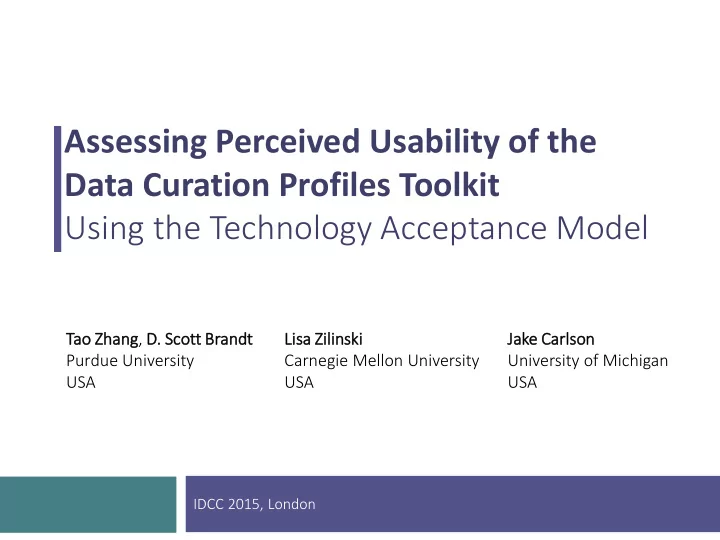

Assessing Perceived Usability of the Data Curation Profiles Toolkit Using the Technology Acceptance Model Tao ao Zhang, D. . Sc Scott Br Brandt Li Lisa Zil ilin inski Jak Jake Carls Carlson Purdue University Carnegie Mellon University University of Michigan USA USA USA IDCC 2015, London
The Data Curation Profiles Toolkit (DCPT) 2 Created at Purdue for librarians to engage researchers in discussion about data Interview protocol Capture information about a dataset across lifecycle Explore how data are used and managed Identify data curation needs Document generated from data interview
Using the DCPT 3 Three-stage process Constructing Preparation Interviews DCP DCPs as community resource Understand researcher needs with data Inform development of data services Data Curation Profiles Directory http://docs.lib.purdue.edu/dcp/
Assessing the DCPT 4 Various data collected on how the DCPT has been used Study on effectiveness of the DCPT Carlson (2013): Increased users’ confidence in discussing data sharing, but time and effort for developing DCP as barrier to use the DCPT Brandt & Carlson (2013): Users recognized utility and impact, and strongly suggested further enhancement for data curation needs (as opposed to data management)
Motivation 5 Formal and structured assessment of the DCPT to reveal factors affecting: User perception Intention to use Difficulties Areas to be improved Challenge for usability evaluation Time limit Task performance measures
Technology Acceptance Model (TAM) 6 Source: Davis (1989) Perceived Usability Perceived usability (PU and PEOU) Predict user acceptance and actual usage of technical systems/tools Critical for overall user experience
Methodology 7 Survey of potential determinants of perceived usability (28 questions measured in 5-point Likert scale) “I have experience in conducting one -and- one interviews.” “It takes __ time to learn the DCP Toolkit.” “I can adjust the questions in the DCP Toolkit for use in different situations.” PU, PEOU, and Intention to Use the DCPT Questionnaire measures adopted from Davis (1989) Open-ended questions Difficulties and obstacles Areas that user liked and could be improved
Methodology 8 Survey sent to 895 registered users of the DCPT website in Dec. 2013 28 measures of determinants 221 responses (24.7%) in a month Most respondents are professional librarians with data management related responsibilities Data analysis Likert ratings of determinants-> Exploratory Factor Analysis -> Regression Analysis Qualitative analysis of open-ended responses
Exploratory Factor Analysis 9 Measure 1 Correlations between Factor 1 variables result from Measure 2 sharing of factors Factor 2 Uncover underlying Measure 3 …… structure of a large set Measure 4 of measured variables Factor n …… Measure N
Factor Analysis Results 10 10 Seven factors extracted for 84.2% of total variance Applicability Time Complexity Experience and Share Training and Help Extensibility Interviewee Requirements Factors in regression models to predict PU, PEOU, and Intention to Use
Regression Results 11 11 Multivariate, stepwise regression models [PU PEOU Intention to Use] = Factors 1-7 + error Perceived Usefulness Estimated β Perceived Ease of Use Estimated β Applicability 3.00 Applicability 1.12 Experience and Share 2.38 Time -1.11 * Training and Help 1.17 Complexity -1.59 Interviewee Requirements -1.71 Intention to Use Estimated β Applicability 0.60 *p-value = 0.064, sample size > 250 needed to Time -0.41 show significance Complexity -0.38 Training and Help 0.29 Extensibility 0.33
Regression Results 12 12 Multivariate, stepwise regression models [Intention to Use] = PU, PEOU + error Intention to Use Estimated β PU 0.156 PEOU 0.054 (p = 0.07 > 0.05) All regression models R 2 around 0.5
Open-ended Questions 13 13 Questions asked in the survey: “If you used the DCP Toolkit in the past, did you encounter any difficulties? If yes, please explain.” (n=46) “If you plan to use the DCP Toolkit, what would be the obstacles you may encounter?” (n=62) “What are the things you like about the DCP Toolkit?” (n=69) “What are the things you think should be improved in the DCP Toolkit?” (n=54) Qualitative analysis method Two independent researchers reviewed and coded responses Two iterations, 66.8% agreement on initial coding and 100% consensus on final coding results
Open-ended Responses 14 14 Themes: Amount of time required to use the DCPT vs. depth of information from completed DCP Structure and format of the toolkit Alignment of the DCPT with particular context Using the DCPT to engage faculty and library community
Open-ended Responses 15 15 Finding the right balance Time required for both researchers and interviewees Depth of information in DCP as good utility Applicability Adapting structure and format to contexts Making decisions based on results Extending the DCPT Compact, “lite version”; online tool Focus on particular data types or fields Community building based on DCPs
Quantitative vs. Qualitative Results 18 18 The balance between time and value Interviewee Requirements affect Perceived Ease of Use Complexity and Time affect Intention to Use Time requirement vs. thoroughness in open-ended responses Training and Help Significant in regressions on Perceived Usefulness, Intention to Use Open-ended responses requested additional help on: Adaptations for different purposes Transforming collected information into DCPs and making decisions
Conclusion 19 19 Technology-Acceptance Model useful for assessment Factor analysis & regressions Significant factors identified for Perceived Usability & Intention to Use Open-ended responses complement quantitative results Usability improvement of the DCPT Reduce time requirement Increase flexibility Training and help
DCP: What We’ve Learned & Going Forward 20 20 DCP 1.0 Constructing Preparation Interviews DCP Paper-based Profiles/ DCP 2.0 Preparation Interview/ Utilizing Best & Training Interact Outputs Practices Tech-based DCP 2.0 Roadmap Workshop, Purdue University, June 2015
Thank you! Tao ao Zhang, D. . Sc Scott Br Brandt Li Lisa Zil ilin inski Jak Jake Carls Carlson Purdue University Carnegie Mellon University University of Michigan USA USA USA zhan1022@purdue.edu ldz@cmu.edu jakecar@umich.edu techman@purdue.edu IDCC 2015, London
Recommend
More recommend